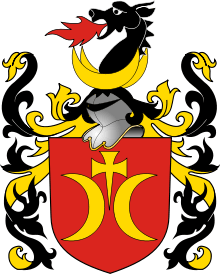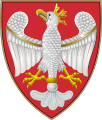Heraldic family


A heraldic family (Polish: ród herbowy, literally, a "coat-of-arms [or heraldic] family") is an institution unique to Polish heraldry, relating to the tradition of a number of — not necessarily consanguineous — szlachta (noble) individual families bearing the same coat-of-arms. The numbers of such individual families often reached several dozen; several hundred were not uncommon.[1][2]
The Polish word "herb" — which derives from the German "Erbe", "inheritance" or "heritage"[3] — denotes both the heraldic family and the coat-of-arms that the heraldic family bore.
The persons and individual families that shared a coat-of-arms ("herb") were called "herbowni", "współherbowni", or "klejnotni" ("bearers of [the same] crest" — from "klejnot", "jewel").
The tradition of heraldic families constitutes one of the hypotheses about the origins of the Polish nobility.
Later developments which affected growth in the sizes of heraldic families included vituperatio nobilitatis (a legal procedure for nullification of a fraudulent nobility membership), and heraldic adoption.
Characteristics
The Polish nobility, the szlachta, had its origins in medieval chivalric clans which provided military support to the king, dukes, or other overlords. Over the centuries, various individual families — indeed, whole noble classes from other nations, for example, Lithuania — were incorporated by adoption into the Polish heraldic-family system.
Exceptions apart, all individual Polish families belonging to the same heraldic family used the same coat of arms, sometimes with minor variations of tincture. The Polish word "herb" denotes both the heraldic family and the coat-of-arms that the heraldic family bore.
Membership in a Polish heraldic family does not always connote consanguinity or even territoriality, as does membership in a Scottish clan, but instead refers to the fact that individual member families belong to the same heraldic family. This is why hundreds of different, sometimes unrelated individual families are to be found within the same heraldic family, all of them being entitled to use the same coat-of-arms. For this reason, rather than paralleling the Scottish-clan model, the Polish heraldic-family system may be considered more akin to the Scandinavian ætt and the Germanic sippia.
Polish coats-of-arms have their individual names, usually stemming from the heraldic family's ancient seat or war cry or from a description of the way the arms are depicted (the so-called "canting arms"). The war-cry derivation of many Polish heraldic-family names has given rise to the now outdated term "proclamatio arms", referring to the names' hortatory nature, which "proclaims" or invokes something. In fact, war-cries consisting of the heraldic-family name alone are nothing particularly Polish and are found in other medieval European nobilities.
The German word "Wappengemeinschaft" ("armorial association") fairly well describes the Polish concept of the "herb" — of the Polish heraldic family and its corresponding coat-of-arms.
In actual everyday life, from the 17th through the 20th centuries, the sense of belonging to an individual family predominated. This is indicated by the organization of most modern Polish armorials, which are arranged by individual-family names, not by the names of their respective coats-of-arms — unlike their 15th-century models, which were arranged by heraldic families, at that time still a legal, genealogical and social reality.
A sense of belonging to a shared armorial lineage existed in the consciousness of the old Polish nobility, down from the Middle Ages, but it was probably more ceremonial and symbolic than real. This was especially true because fairly often, particularly among the poorer nobility in the 19th century, accidental — sometimes deliberate — instances occurred of individuals misidentifying themselves, to the heraldic offices of the partitioning countries, with various coats-of-arms. In this way, different members of the same individual family sometimes formally obtained recognition of their membership in different heraldic families. At the same time, Polish magnate families and some middling landowning families, contrary to Polish armorial custom, received titles such as "Prince", "Count", or "Baron" along with their “own” particular coat-of-arms — some variation of their original herb — from the three partitioning powers, the French empire, the Pope, or other sovereign.
See also
| |||||||||||||||||||||||||
References
- ↑ Maurycy Orgelbrand - (praca zbiorowa): Słownik Języka Polskiego. Wilno 1861: Wydawnictwa Artystyczne I Filmowe - /reprint/ - Warszawa, 1986, s. 398.
- ↑ "Tworzenie się polskich rodów heraldycznych" ("Creation of Polish Heraldic Families"), Pro Fide, Lege et Rege no. 1 (48) /2004 (retrieved February 22, 1013)
- ↑ Słownik wyrazów obcych [Dictionary of Foreign Expressions], Warsaw, Państwowe Wydawnictwo Naukowe, 1971, p. 274.
